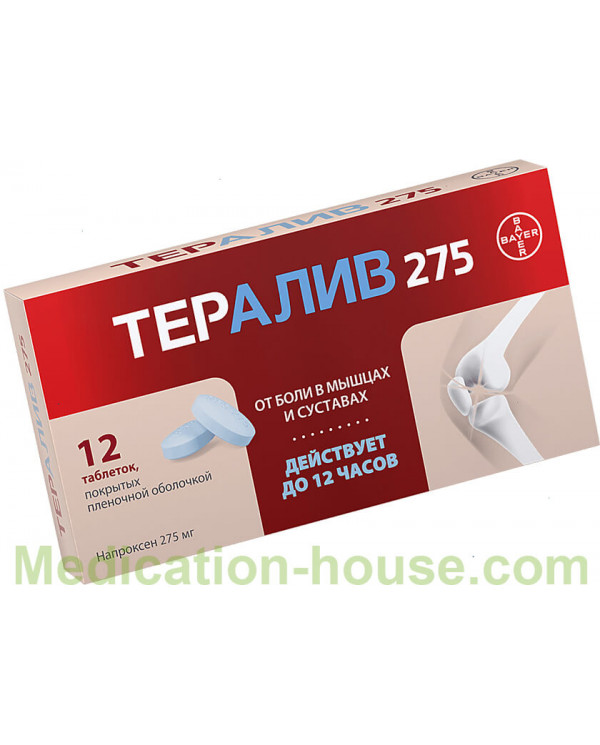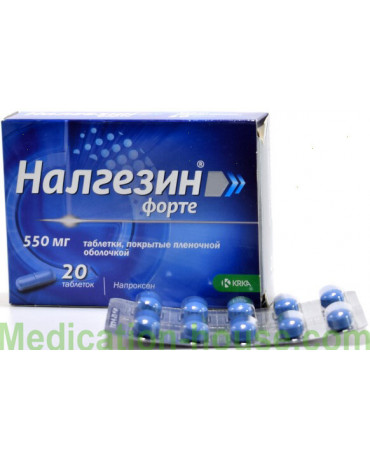Instruction for Teraliv
You can buy Teraliv here
Composition
1 tablet contains
Active ingredient: naproxen sodium 275 mg.
Excipients: microcrystalline cellulose 55.00 mg, povidone K-30 12.50 mg, talc 15.75 mg, magnesium stearate 2.63 mg; film shell: opadry blue YS-1-4215 9 mg: macrogol 8000, indigo carmine, titanium dioxide, hypromellose.
Description
Oval biconvex tablets, film coated, blue color. On one side of the tablet is the engraving "NPS-275". On a break, the tablet has a white core.
Pharmacotherapeutic group: Non-steroidal anti-inflammatory drug.
Pharmacodynamics
The drug Teraliv 275 is naproxen, has analgesic, antipyretic and anti-inflammatory effects. The mechanism of action is associated with non-selective inhibition of cyclooxygenase-1 and -2 activity (COX-1, COX-2).
The drug Teraliv 275, film-coated tablets, dissolves well, is rapidly absorbed from the gastrointestinal tract and provides a rapid onset of anesthetic effect.
Pharmacokinetics
Quickly and completely absorbed from the gastrointestinal tract. Bioavailability - 95% (food intake practically does not affect either the fullness or the rate of absorption). The time to reach maximum concentration is 1-2 hours. Communication with plasma proteins> 99%. The half-life is 12-15 hours. Metabolism occurs in the liver to dimethylnaproxen with the participation of the isoenzyme SUR2S9. Clearance - 0.13 ml / min / kg. Excreted in 98% of the kidneys, 10% is excreted unchanged, with bile - 0.5-2.5%. Equilibrium plasma concentration is determined after taking 4-5 doses of Teraliv (2-3 days).
In renal failure, accumulation of metabolites is possible.
Indications for use
Diseases of the musculoskeletal system (rheumatic lesions of soft tissues, osteoarthritis of the peripheral joints and spine, including with the radicular syndrome, tendovaginitis, bursitis).
Pain syndrome mild or moderate severity: neuralgia, ossalgia, myalgia, lumboischialgia, post-traumatic pain syndrome (sprains and bruises), accompanied by inflammation, headache, migraine, algomenorrhea, toothache.
In the complex treatment of infectious and inflammatory diseases of the ear, throat, nose with severe pain (pharyngitis, tonsillitis, otitis media).
Feverish syndrome with colds and infectious diseases.
The drug Teraliv 275 is used for symptomatic therapy (to reduce pain, inflammation and reduce fever) and does not affect the progression of the underlying disease.
Contraindications for Teraliv
Hypersensitivity to naproxen or naproxen sodium.
A complete or incomplete combination of bronchial asthma, recurrent nasal polyposis or paranasal sinuses and intolerance to acetylsalicylic acid and other nonsteroidal anti-inflammatory drugs (NSAIDs) (including a history of).
Period after coronary artery bypass surgery.
Erosive and ulcerative changes in the mucous membrane of the stomach or duodenum 12, active gastrointestinal bleeding.
Inflammatory bowel disease (ulcerative colitis, Crohn's disease) in the acute phase.
Hemophilia and other bleeding disorders and disorders of hemostasis.
Cerebrovascular bleeding or other bleeding.
Decompensated heart failure.
Severe liver failure or active liver disease.
Severe renal failure (creatinine clearance (CC) less than 30 ml / min), progressive kidney disease, confirmed hyperkalemia.
Pregnancy, breastfeeding period.
Children's age up to 15 years.
Carefully
Coronary heart disease, cerebrovascular diseases, congestive heart failure, dyslipidemia / hyperlipidemia, diabetes, peripheral artery disease, smoking, renal impairment (CC 30-60 ml / min), anamnestic data on the development of ulcerative lesions of the gastrointestinal tract (GIT) , presence of Helicobacter pylori infection, use in elderly patients, systemic lupus erythematosus or mixed connective tissue diseases (Sharpe syndrome), long-term use of NSAIDs, frequent alcohol consumption, elye somatic diseases, concomitant therapy following drugs: anticoagulant (e.g., warfarin), antiplatelet agents (e.g., aspirin, clopidogrel), oral corticosteroids (e.g., prednisone), selective serotonin reuptake inhibitor (such as citalopram, fluoxetine, paroxetine, sertraline) .
Pregnancy and lactation
The drug Teraliv 275 is not recommended for use during pregnancy and during breastfeeding.
Dosage and administration
Inside Tablets should be taken with a sufficient amount of water.
Adults and children aged 15 and over
Usually the daily dose used to relieve pain is 2-3 tablets (550-825 mg). The maximum daily dose - 3 tablets (825 mg). Duration of use - no more than 5 days. When using the drug Teraliv 275 as a febrifuge, the initial dose is 2 tablets, then 1 tablet (275 mg) is taken every 8 hours. For the prevention and treatment of migraine attacks, the initial recommended dose is 2 tablets (550 mg), if necessary, you can take 1 tablet (275 mg) every 8-12 hours. The maximum daily dose - 3 tablets (825 mg). To relieve menstrual cramps and spasms, pain after the introduction of intrauterine devices and other gynecological pains, it is recommended to administer Teraliv in an initial dose of 2 tablets (550 mg), then 1 tablet (275 mg) every 8 hours.
Children
Teraliv 275 is contraindicated for use in children under 15 years of age.
Elderly patients (≥ 65 years)
Patients over 65 should take Teraliv as needed every 12 hours.
To reduce the risk of adverse events from the gastrointestinal tract, the drug should be taken in the minimum effective dose with the minimum possible short course.
If you have the impression that the effect of Teraliv is very strong or weak, inform your doctor or pharmacist.
Side effect
Adverse effects that may develop during naproxen treatment are classified according to the following frequency of occurrence: very often (> 1/10), often (from ≥1 / 100 to <1/10), infrequently (from ≥ 1/1000 to <1/100), rarely (from ≥1 / 10000 to <1/1000), very rarely (<1/10000), frequency unknown (cannot be determined based on available data).
Disorders of the gastrointestinal tract:
most often observed adverse events from the gastrointestinal tract. The development of peptic ulcers, perforation or gastrointestinal bleeding is possible, sometimes with fatal outcome, especially in elderly patients (see section "Special Instructions").
In each group, adverse events are listed in descending order of severity.
Violations of the blood and lymphatic system
Infrequently: eosinophilia, granulocytopenia, leukopenia, thrombocytopenia.
Nervous system disorders
Often: headache, vertigo, dizziness, drowsiness.
Infrequently: depression, sleep disturbances, inability to concentrate, insomnia, indisposition.
Violations by the organ of vision
Often: blurred vision.
Disturbances from an organ of hearing and labyrinth disturbances
Often: tinnitus, hearing loss.
Infrequently: decrease in hearing.
Heart disorders
Often: puffiness, feeling of heartbeat.
Infrequently: congestive heart failure.
Disorders of the respiratory system, chest and mediastinum
Often: shortness of breath.
Infrequently: eosinophilic pneumonia.
Disorders of the gastrointestinal tract
Often: constipation, abdominal pain, dyspepsia, nausea, diarrhea, stomatitis, flatulence.
Infrequently: gastrointestinal bleeding and / or perforation of the stomach, bloody vomiting, melena, vomiting.
Very rarely: relapse or exacerbation of ulcerative colitis or Crohn's disease.
Frequency unknown: gastritis.
Disorders of the liver and biliary tract
Infrequently: increase in activity of "liver" enzymes, jaundice.
Violations of the skin and subcutaneous tissues
Often: skin itch, skin rash, ecchymosis, purpura.
Infrequently: alopecia, photodermatosis.
Very rarely: bullous reactions, including Stevens-Johnson syndrome and toxic epidermal necrolysis.
Disorders of the musculoskeletal and connective tissue
Infrequently: myalgia and muscle weakness.
Kidney and urinary tract disorders
Infrequently: glomerulonephritis, hematuria, interstitial nephritis, nephrotic syndrome, renal failure, renal papillary necrosis.
General disorders and disorders at the site of administration
Often: thirst, increased sweating.
Infrequently: hypersensitivity reactions, menstrual disorders, hyperthermia (chills and fever).
In the treatment of NSAIDs, the appearance of edema and symptoms of heart failure, increased blood pressure have been reported.
Clinical studies and epidemiological data suggest that the use of certain NSAIDs (especially high doses and long-term therapy) may be associated with a slight increase in the risk of arterial thrombosis (for example, myocardial infarction or stroke).
Undesirable effects whose causal relationship with the use of naproxen has not been established
Blood and lymphatic system disorders: aplastic anemia, hemolytic anemia.
Nervous system disorders: aseptic meningitis, cognitive dysfunction.
Violations of the skin and subcutaneous tissues: erythema multiforme, photosensitivity reactions, such as late skin porphyria and epidermolysis bullosa, urticaria.
Vascular disorders: vasculitis.
Common disorders and disorders at the injection site: angioedema, hyperglycemia, hypoglycemia.
If you have noticed similar phenomena, stop taking Teraliv and, if possible, consult a doctor.
Overdose
Symptoms
A significant overdose of naproxen can be characterized by drowsiness, dyspeptic disorders (heartburn, nausea, vomiting, abdominal pain), weakness, tinnitus, irritability, and in severe cases, bloody vomiting, melena, impaired consciousness, convulsions, and renal failure.
Treatment
A patient who has taken a randomly or deliberately large amount of Teraliv 275 needs to wash the stomach, take activated charcoal, and carry out symptomatic therapy: antacids, H2-receptor blockers, proton pump inhibitors. Hemodialysis is ineffective.
Interaction with other drugs
When treating with anticoagulants, it should be borne in mind that naproxen may increase bleeding time. Do not use the drug Teraliv 275 simultaneously with acetylsalicylic acid, other NSAIDs, including selective cyclooxygenase-2 inhibitors (increased risk of side effects).
Patients simultaneously receiving hydantoins, anticoagulants, or other drugs that bind to a large extent to plasma proteins should monitor signs of potentiation of action or overdose of these drugs.
TeraLiv 275 may reduce the antihypertensive effect of propranolol and other beta-blockers, and may also increase the risk of renal failure associated with the use of angiotensin-converting enzyme (ACE) inhibitors.
NSAIDs can reduce the diuretic action of diuretics. Under the action of naproxen, the natriuretic effect of furosemide is inhibited. Diuretics can increase the risk of nephrotoxicity of NSAIDs.
Inhibition of renal clearance of lithium leads to an increase in the concentration of lithium in the blood plasma. Taking probenecid increases the concentration of naproxen in the blood plasma. Cyclosporine increases the risk of developing renal failure.
Naproxen slows the excretion of methotrexate, phenytoin, sulfonamides, increasing the risk of developing their toxic action.
Antacid preparations containing magnesium and aluminum reduce naproxen absorption.
Myelotoxic drugs increase the hematoxicity of Teraliv.
According to in vitro studies, simultaneous use of naproxen and zidovudine increases the concentration of zidovudine in the blood plasma.
Simultaneous use of corticosteroids may increase the risk of ulceration or gastrointestinal bleeding.
NSAIDs can enhance the action of anticoagulants such as warfarin.
The simultaneous use of naproxen and antiplatelet drugs, selective serotonin reuptake inhibitors increases the risk of gastrointestinal bleeding.
It is not recommended to take NSAIDs at the same time for 8-12 days after applying mifepristone.
The simultaneous use of NSAIDs and tacrolimus increases the risk of nephrotoxicity.
special instructions
Do not exceed the doses indicated in the instructions. To reduce the risk of adverse events from the gastrointestinal tract, use the minimum effective dose of the shortest possible course.
If pain and fever persist or become stronger, consult a doctor. Patients with bronchial asthma, with bleeding disorders, as well as patients with hypersensitivity to other analgesics before taking the drug Teraliv 275 should consult with your doctor.
Caution should be given to patients with liver disease and renal failure. In patients with renal insufficiency, creatinine clearance must be monitored. When QA is less than 30 ml / min, naproxen is not recommended. In chronic alcoholic and other forms of cirrhosis, the concentration of unbound naproxen increases, so lower doses are recommended for these patients. After two weeks of use of Teraliv, monitoring of liver function indicators is necessary.
TeraLiv 275 should not be taken with other anti-inflammatory and analgesic drugs, with the exception of doctor's prescriptions.
Elderly patients are also recommended lower doses.
Naproxen should be avoided within 48 hours prior to surgery. If necessary, determine the 17-corticosteroids drug should be canceled 48 hours before the study. Similarly, naproxen may influence the determination of 5-hydroxyindolecetic acid in urine.
The use of naproxen, as well as other drugs that block the synthesis of prostaglandins, can affect fertility, so it is not recommended for women who are planning a pregnancy.
Each tablet of the drug Teraliv 275 contains approximately 25 mg of sodium. When limiting salt intake, this must be taken into account.
Influence on ability to drive machinery and other vehicles
Naproxen slows down the response rate in patients. This should be considered when driving and performing tasks that require increased attention.
Release form
Film-coated tablets, 275 mg.
On 12 tablets in PVC / Al the blister. On 1 or 2 blisters together with the application instruction in a pack cardboard.
Storage conditions
At a temperature not higher than 25 ° С.
Keep out of the reach of children.
Shelf life - 5 years.
Do not use after the expiration date.
Terms of sell
You don't need a prescription to buy Teraliv.



